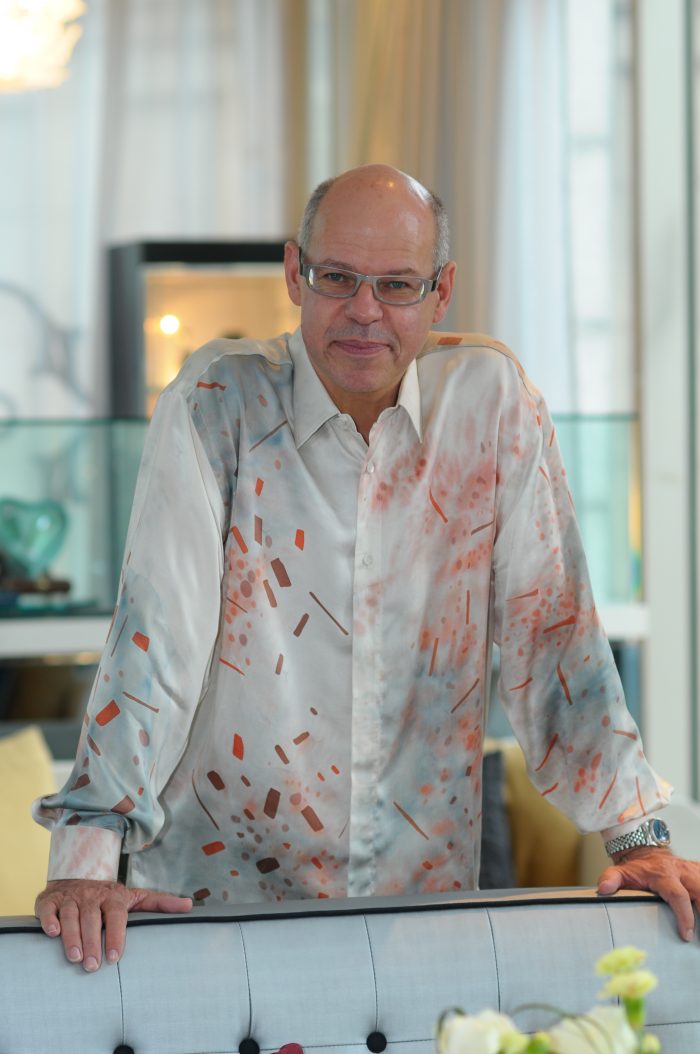By Alexandra Low

“To anybody’s imagination, the very man who held Daimler Chrysler Malaysia at the helm for years contributed only to the automotive industry or knew only business, or a combination of both. That albeit being a reality, showed only a fragment of his life—one that burst with the colours of Malaysian art.
Dato’ Frank insisted that he was nobody in the fashion scene; his blue eyes revealed his broiling discomfort when he touched the fashion topic. It would not be at all comical had it not come from the lips of one of the first people who established the Malaysia International Fashion Awards (MIFA). He subsequently moved on to witness the growth of other influential fashion bodies like Malaysia Official Designers Association (MODA) and Stylo.
By right, if a man confessed that he had little life apart from his work, it could only mean one thing: he did have little life apart from work. He has three automotive-related companies in Malaysia namely FS Consulting Sdn Bhd, German Motors Sdn Bhd and Chemplex Continental Sdn Bhd. But, the very man who helped nurture the growth of Malaysian fashion arena was also the one of the leading sponsors of Kuala Lumpur Performing Arts Centre. His passion for beautiful things did not stop at pre-dawn antique shopping on the dark streets of Beijing. He also visited rural villages in Terengganu to see for himself the tedious production of Malaysian traditional dye-print art.

“I’m not a fashion icon,” he stressed again, “I’m not even fashionable to begin with.” Yet his lips curved upwards whenever he spoke of the growth of local fashion as well as performing arts industries. “I just like to create things and make things happen. I believe [that] development isn’t about majestic architectural, but more on education.” To him, education meant two types of platforms: one, for young people to express their thoughts and ideas; another, exposure—in short, a stage basking with spotlights and flashlights.
Dato’ Frank watched local star designers, namely Khoon Hooi and Melinda Looi, emerged from the platforms he helped erect. Those were only two success cases. To him, there were thousands more aspiring art students who would one day shape the fashion world and these young people deserved to be seen. “Malaysia is a vibrant country. Unlike Europe, here, you can do Indian fashion, Islamic fashion, Chinese fashion and so much more!” The possibilities were endless. That was the major reason why he got himself involved in the leading fashion events.
Although happy for Khoon Hooi and others who had made a name for themselves, he was disheartened that not many batik designers seized the opportunities to showcase their works in the annual event. “Batik is not something every country has.” All the more, batik has to be treasured and promoted. Despite efforts by the government, its mark in the international fashion scene is still minimal. Batik’s confused status explains its lack of success.
“Somebody must make a decision. Batik has to be either handicraft or fashion,” he said. The rationale, simple business strategy: “If [batik is] handicraft, it can afford to retain its current image. It can be hand drawn, individually produced and expensive… But if batik is to be more [towards] fashion, then it has to be mass produced, made younger and affordable. Fashion isn’t about couture only. It has to reach the masses.”
“To the younger generation, batik looks old… boring… something people wear to formal functions…,” he sighed. Batik had not permeated deep enough into the Malaysian society as a fashionable wear. To be fashionable, batik must rise to the frontline of everything trendy. To do that, it must first be competitive enough to survive fast-moving trends and ephemeral tastes. “That means, it must be produced efficiently,” he declared, “and that will make it affordable.”
“I can only speak from the business point of view,” he said again. And it was the lack of business views that limped the progress of the batik industry. Many batik designers were not business savvy. Many were poor farmers or fishermen—people who relied heavily on government’s subsidies and financial assistance—trying to pocket some extra income dyeing cloths. These people just did not have the capital to mass produce.
The development of batik into something synonymous to the national identity had been discussed for too many years, and yet the results were disappointing. He believed that the core issue was not inept marketing, nor was it horrid quality. “Really, someone… like the Ministry of Arts, Culture and Heritage… should decide how they want the world to see batik. A repositioning would give batik another beginning on a new footing.”
Repositioning requires smart business thinking. “It’s worth thinking (on how to improve the batik industry). I will think about it and we can share more next time,” he promised. But, before that, batik must know whether it is handicraft or fashion.”

